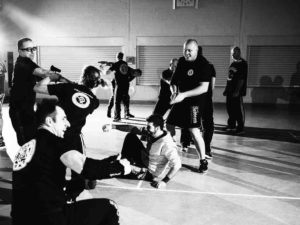BKMA Leeds, we focus on preparing students for the reality of self-defence situations—not just the techniques but the chaotic, stressful environments in which they might need to act. Real-world violence isn’t neat or predictable. It’s fast, messy, and often overwhelming. Adrenaline floods your body, your heart races, and clear thinking becomes a challenge. That’s why one of the key components of our training is stress and adrenaline simulation—teaching you not only how to defend yourself but how to do it when your body is under immense pressure.
Why We Simulate Stress
In real-life confrontations, your body undergoes a physiological response known as the “fight, flight, or freeze” reaction. Your heart rate spikes, your breathing quickens, and you can experience tunnel vision. These natural responses can limit your ability to think clearly and react quickly. Unfortunately, in many martial arts classes, the controlled environment doesn’t reflect the stress of a real-world attack.
At British Krav Maga Leeds, we ensure that training replicates the unpredictable, high-pressure nature of violent encounters. The aim is to condition your body and mind to handle stress and make smart, efficient decisions when it counts.
How We Simulate Stress in Krav Maga Training
Our training is designed to recreate the physical and mental stress you’ll experience during an actual attack. Here’s how we do it:
- High-Intensity Drills
We often start with intense physical exercises—like sprints, push-ups, or burpees—before throwing students into self-defence drills. By doing this, we get your heart rate up and force you to practice under exhaustion. This mimics the reality of a street confrontation, where you won’t be fresh and prepared for action. The goal is to develop your ability to stay composed and effective, even when tired and breathless. - Multiple Attackers
In many real-world situations, you won’t just face one attacker. We simulate group assaults by having multiple partners attack simultaneously. This forces you to think quickly, defend from different angles, and use your surroundings to your advantage. By practicing against multiple attackers, you build situational awareness and learn how to manage the overwhelming feeling of being outnumbered. - Sensory Overload
During an actual assault, your senses can be overwhelmed by loud noises, shouting, or even flashes of light. In training, we recreate this kind of sensory overload by incorporating shouting, music, or distractions into drills. This helps you stay focused on defending yourself, no matter what’s happening around you. - Surprise Attacks
You’re rarely ready for an attack when it happens. To prepare for this, we incorporate surprise drills into classes. You may be walking around, chatting, or practicing techniques when a surprise attacker jumps in and initiates an attack. This helps you practice reacting instinctively when you least expect it. - Defending from Vulnerable Positions
Many real-life attacks happen when you’re at a disadvantage—whether you’re sitting, on the ground, or pinned against a wall. We focus on training from these vulnerable positions, so you know how to defend when you don’t have the perfect stance or leverage. This kind of training builds your confidence to act decisively, even when the odds aren’t in your favour.
Dealing with the Adrenaline Dump
A big part of handling stress in a fight is controlling your adrenaline. When adrenaline floods your system, it can impair your fine motor skills and make it harder to think clearly. At British Krav Maga Leeds, we teach techniques like controlled breathing and mental focus exercises to help you manage that adrenaline dump. By practicing how to stay calm in stressful situations, you learn to control your emotions and make better decisions in the heat of the moment.
Scenario-Based Training
Scenario-based training is one of the most effective ways to simulate real-world violence. In our classes, we often set up realistic scenarios where students defend themselves in environments like hallways, staircases, or parking lots. These scenarios aren’t just about physical techniques—they also test your ability to stay aware, make quick decisions, and escape safely.
This type of training builds muscle memory—the ability to react instinctively without overthinking. The more you practice these scenarios, the more natural it becomes to defend yourself under real-life pressure.
Building Mental Resilience
Krav Maga isn’t just about physical defence—it’s about building the mental resilience to face any situation. In our training, we emphasize the mindset of “never giving up”. You might be tired, outnumbered, or injured, but Krav Maga teaches you to keep fighting. We simulate difficult scenarios that push you to your limits, so when you face a real-world situation, you have the confidence to push through fear and fatigue.
Training Beyond Technique
At our Krav Maga club, we believe that self-defence isn’t just about knowing the right moves—it’s about knowing how to apply them under pressure. By incorporating stress and adrenaline simulation into our training, we ensure that our students are prepared for the chaos and unpredictability of real-world violence.
So next time you’re in class, push yourself beyond just mastering the techniques. Embrace the stress, simulate the chaos, and remember that in a real fight, your ability to stay calm and react quickly could make all the difference.
Interested in trying Krav Maga and experiencing real-world scenario training?
Join us at British Krav Maga Leeds for a class and start training for the real world today!

